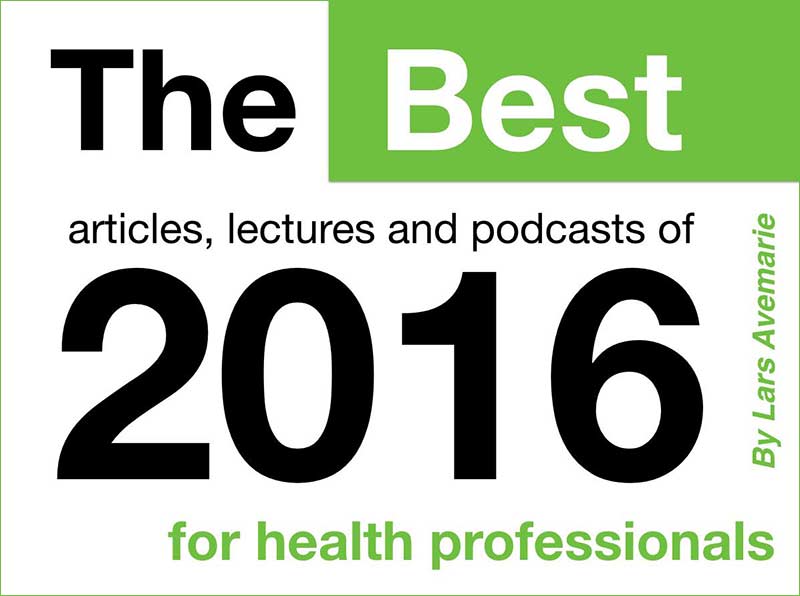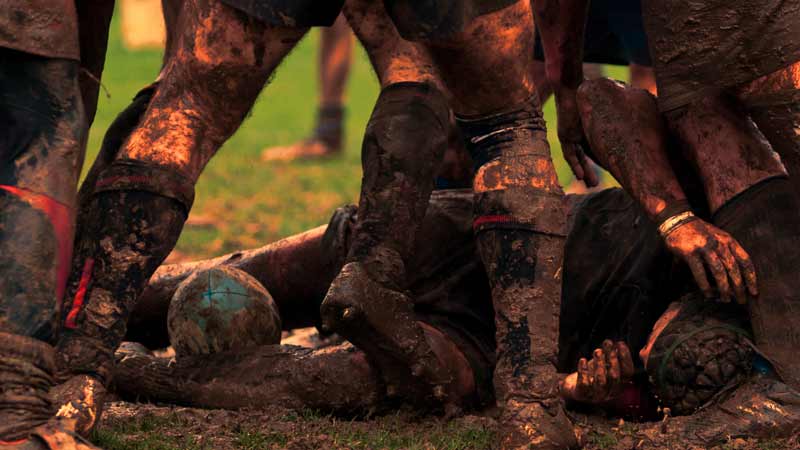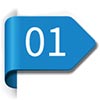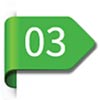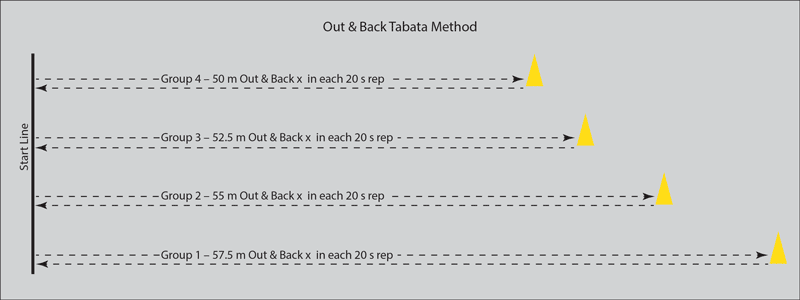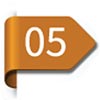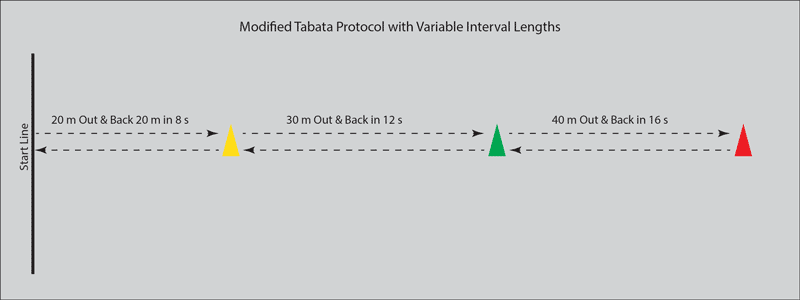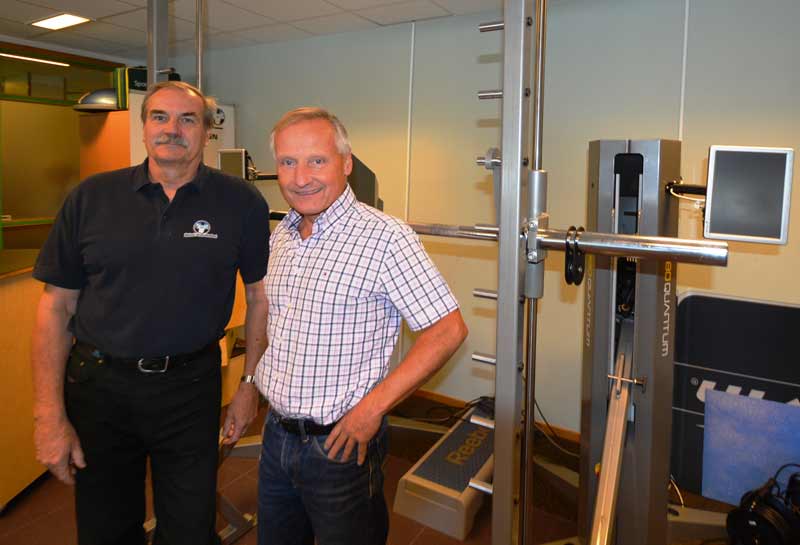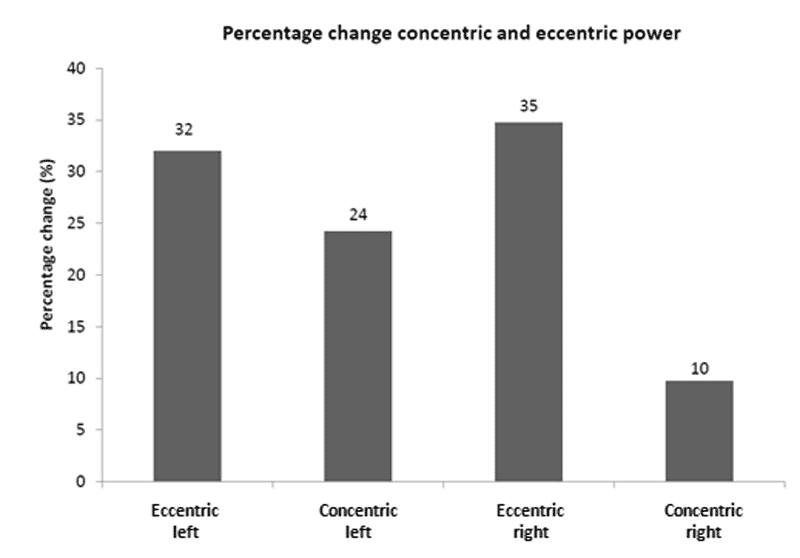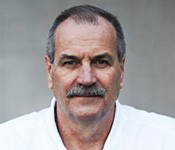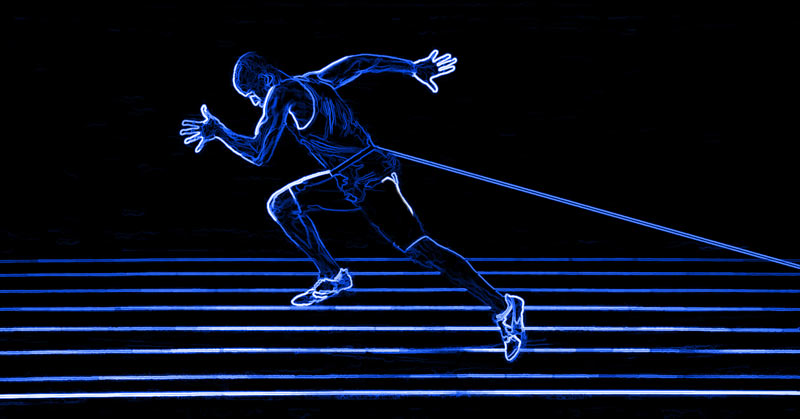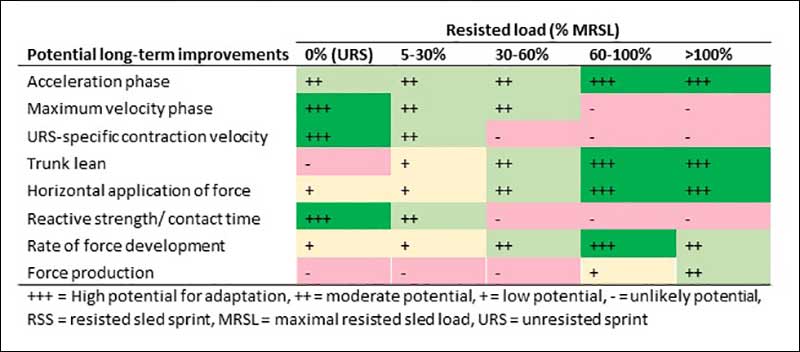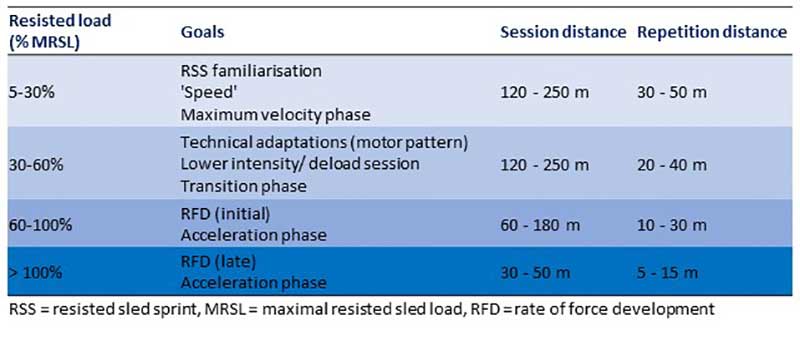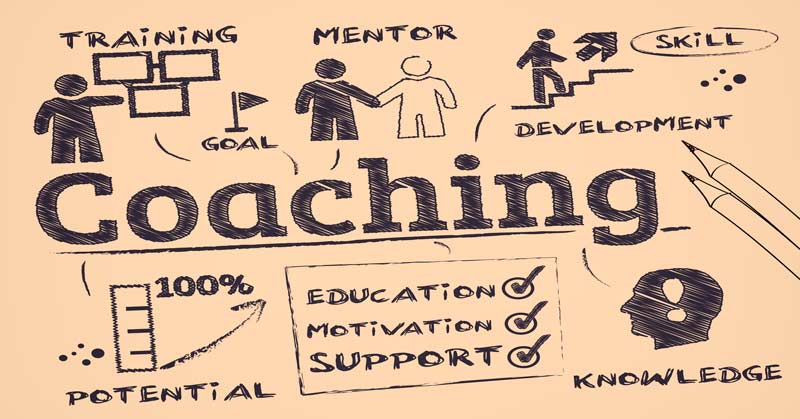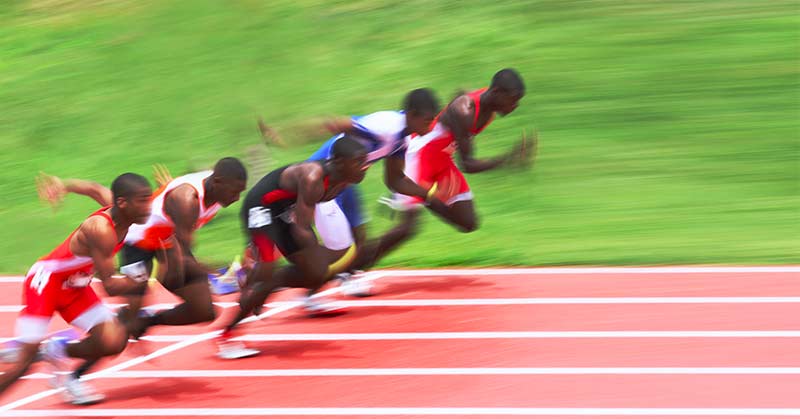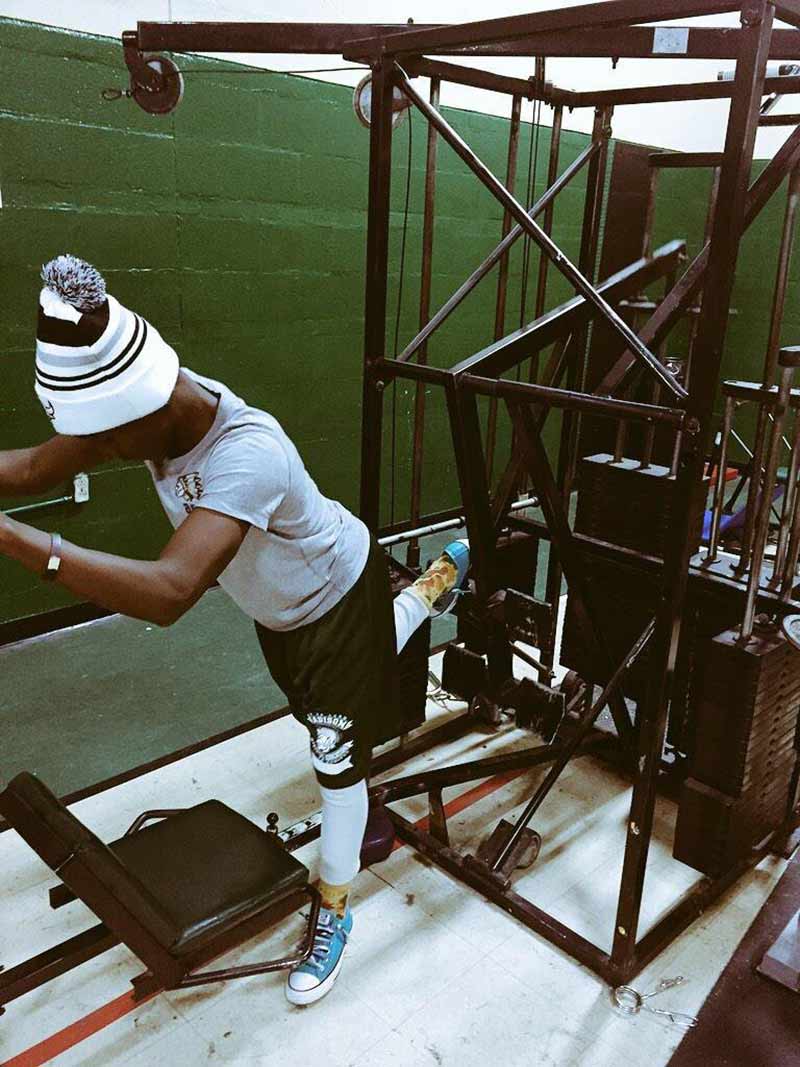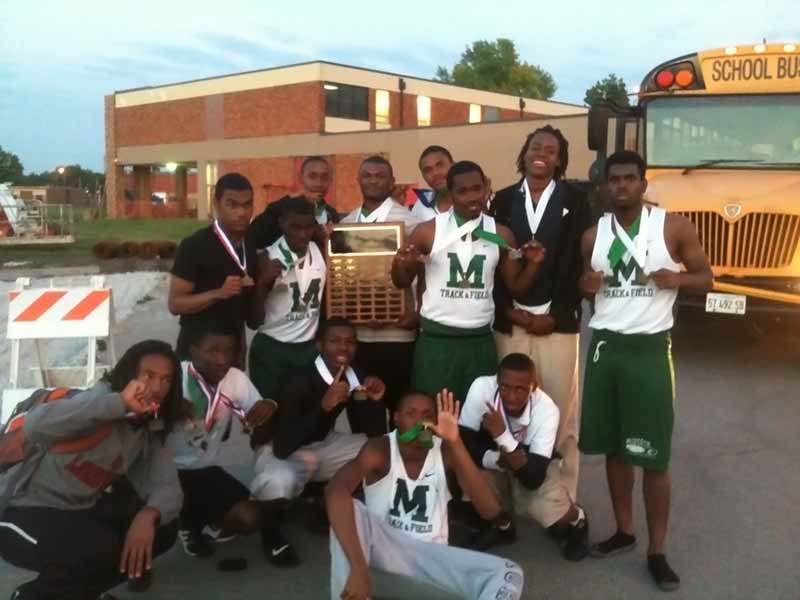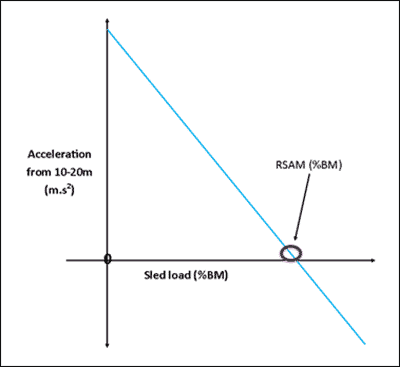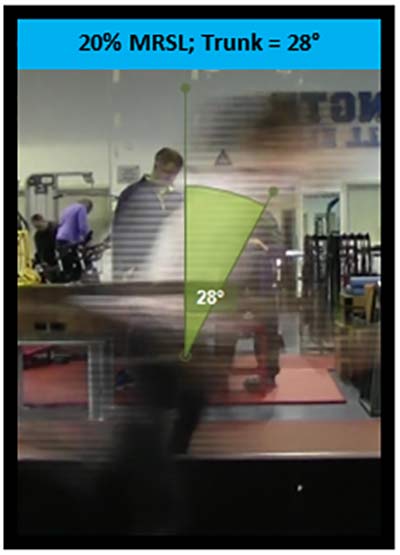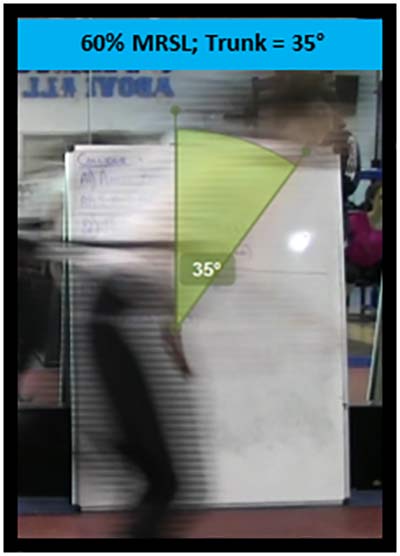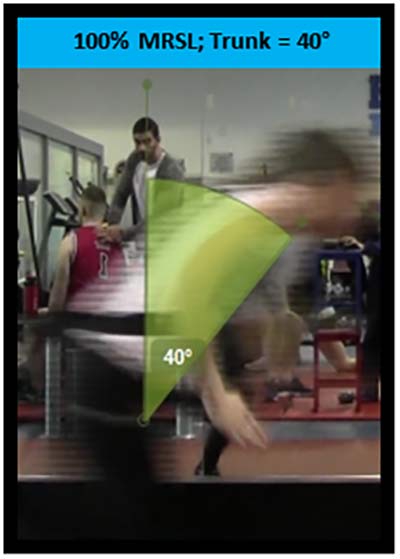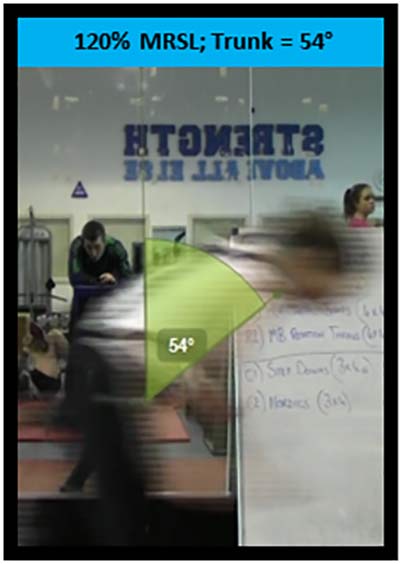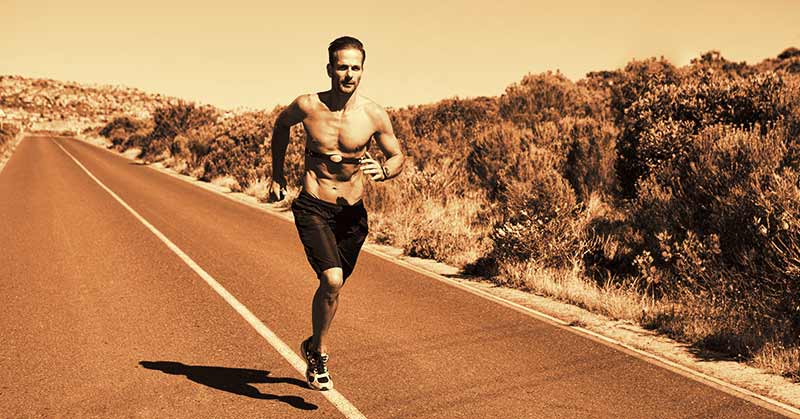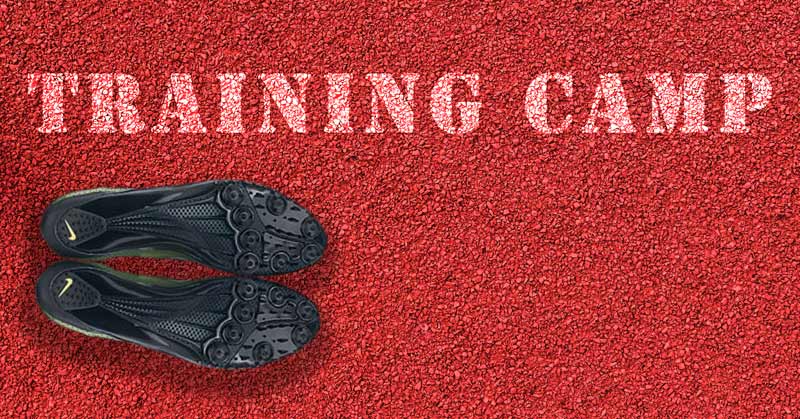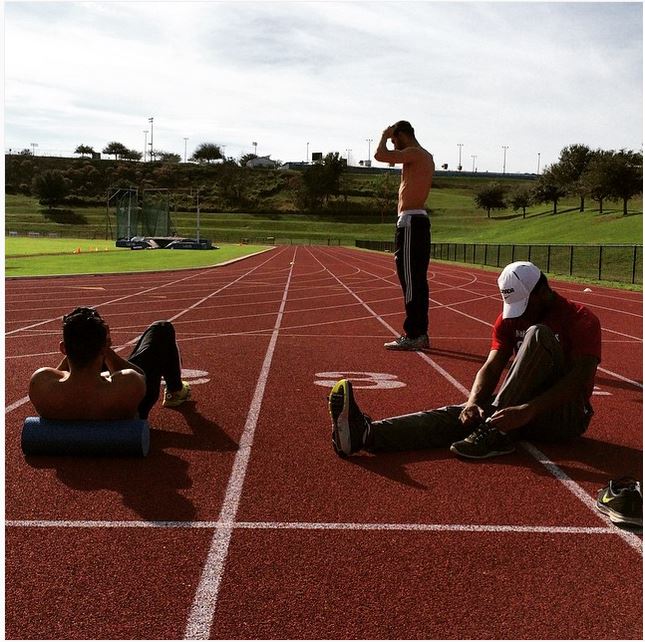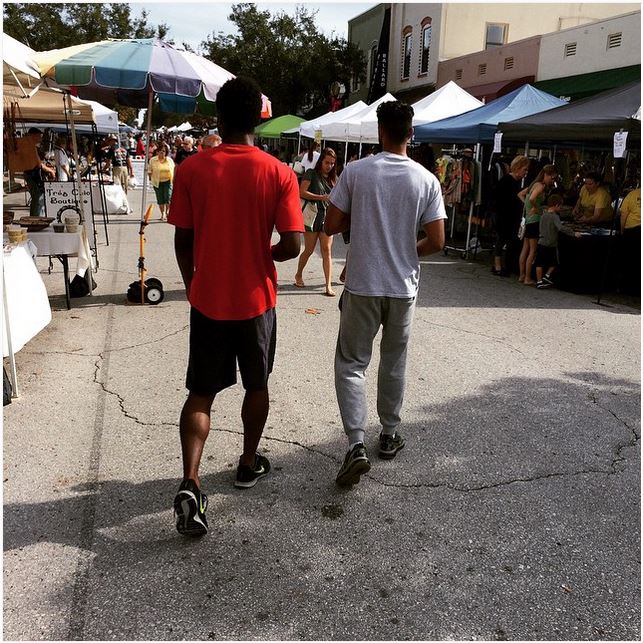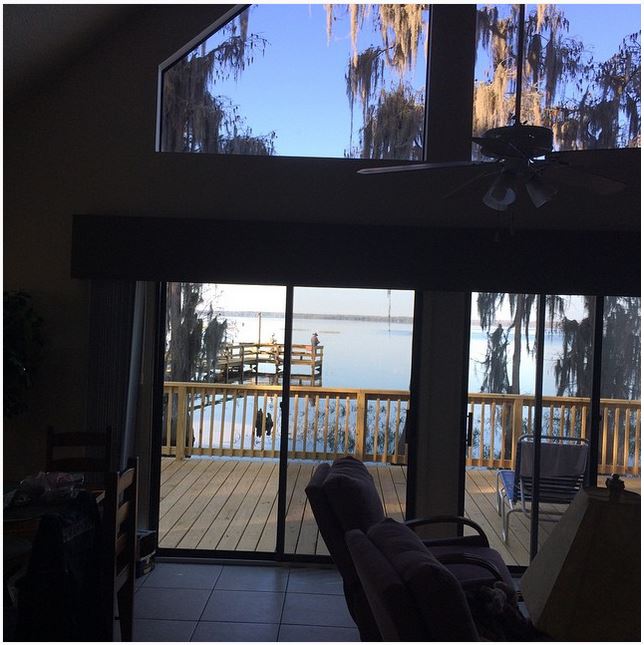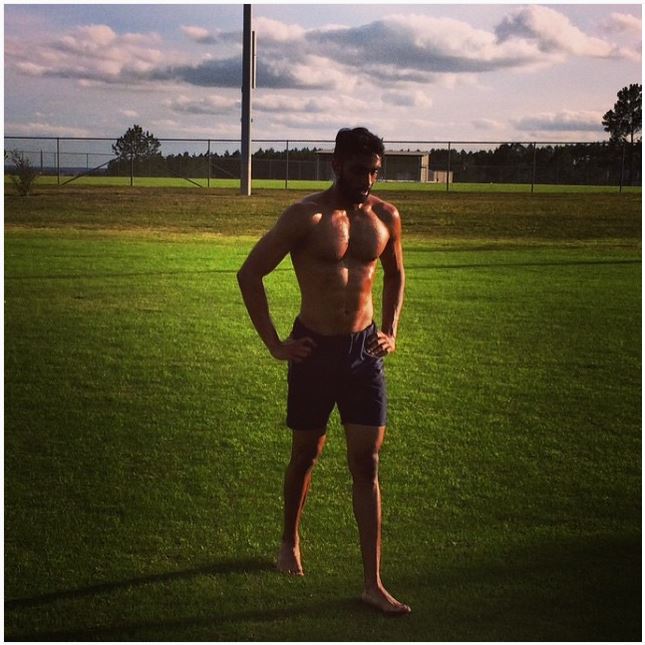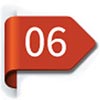
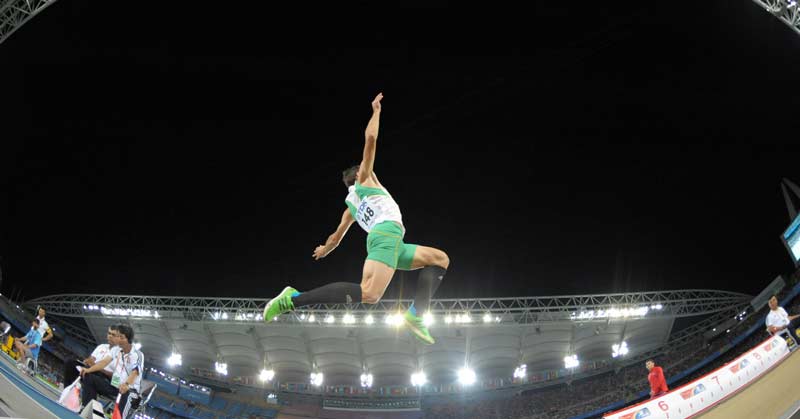
Technical Training
Technical training is an important element in any training program. For a long jumper, it can take many forms. Some aspects are subtle and, at first glance, may not appear related to the technical model. I believe, however, that all training components can be linked in some way, and it’s simply a matter of perspective and deeper thinking that allows us to make the connection.
Throughout this article, I will discuss areas of technical training that I believe essential for the development of long jumpers. I will categorize each element and provide a clear understanding of how to build a comprehensive technical training system. I will also include a guide to long jumping technique and discuss important technical aspects as they pertain to particular drills and training methods.
Developing the Approach Run
I will begin with the approach run, the most important aspect of the long jump, from both a technical and performance perspective.
More than 95% of the distance achieved during the long jump is determined by the speed generated during the athlete’s approach. A successful approach run is complex and involves several distinct components. I’ll focus on the technical aspects of each training component.
Acceleration
As an absolute quality, the ability to accelerate plays an important role for maximum velocity. During an approach run, where most athletes are limited to 18-23 strides (35-55m), acceleration technique is considerably important. The goal is not only to achieve near maximum velocity but to do so in rhythm with correct posture and timing.
A jumper must accelerate smoothly and relaxed for successful transitioning during the final 10m and through takeoff. The ability to accelerate fast and relaxed while demonstrating upright running mechanics is key and requires considerable practice.
Depending on the time of year, acceleration sessions generally occur 2-3 times per week. Running at lower intensities is included on other days and serves well for rhythm, technique, and recovery.
Acceleration sessions require repeated bouts of sprinting over 20-40m performed at 95-100% effort. Relaxation and smooth sprinting mechanics are key and must transfer to approach running.
Max Velocity
Our goal is to develop athletes who will reach high maximum velocities without straining or demonstrating inefficient sprint technique.
As stated, horizontal velocity is the largest determining factor when achieving elite distances. Due to the technical aspects of the takeoff and flight phases, however, it is rarely possible or advantageous for athletes to reach 100% of maximum speed during their approach. Therefore, the relative approach speed becomes very valuable.
We know the approach velocities required to achieve certain distances, and we know the relationship between horizontal velocities and takeoff angle. Through maximum speed development, we can create a speed buffer. This buffer allows the athlete to achieve high velocities while maintaining optimal technique and focus without straining or feeling out of control.
Developing maximum velocity starts with the ability to both accelerate efficiently and maintain a high level of coordination and synchronicity over a 35-55m distance.
Fly sprints are particularly useful when focusing on max velocity mechanics and high-speed output in isolation. After a period of acceleration work, I gradually introduce fly sprints to the program. I like to use a 35m gradual acceleration (25m for women) into a 10-30m zone. I’ve found that 95-98% of max velocity can be achieved via a gradual (slightly sub max) acceleration while maintaining a smooth and relaxed sprinting technique. Fly sprints, my favorite method, closely resemble a long jumper’s approach.
I generally progress the speed program by including Sprint–Float–Sprints (SFS). SFS creates the perfect bridge between fly sprints and special speed endurance development that occurs next and last in the speed progression. I start around 90m total length and progress to 150m. The total length is broken down into sections. For example, a 90m SFS may include a 30m acceleration followed by a 30m float section followed by a final 30m sprint.
It’s important to understand the purpose and requirements of the float section. During the float, I cue the athlete to switch off the burners while maintaining as much speed as possible. The approach run requires relaxed and controlled speed. Achieving high speed in this manner is a skill, and the practice of smooth accelerations, fly sprints, SFS, and slower extensive tempo running sessions all contribute to development.
The final progression involves special speed endurance work. This follows two basic formats, one for short speed endurance and one for long speed endurance. A short speed endurance protocol could be 2x5x40m sprints at 90% with 2 min and 6 min recovery. One protocol for long speed endurance could be 4x150m sprint at 90% with 8 min recovery. Developing speed endurance enhances an athlete’s freedom when running at high speeds; another method to help improve high velocity sprinting while relaxed. Without specifically discussing sprint technique, we can see the common technical themes throughout all speed development methods as they relate to the long jump approach.
Approaches
Approach development becomes the focal point throughout the competitive period and special training phases. Here, the countless hours developing technique and sprinting speed are put to practical use.
The most important technical cue word is rhythm. Rhythm has a personal touch. A successful approach has a steady and consistent build of energy, and achieving this can be very difficult. It requires a certain connection to the approach and a high-level kinesthetic awareness. Both can be learned and practiced.
Approach development starts early in the program and should be a conscious thought during build ups, strides, accelerations, and fly sprints. Rhythmic sprint drills can also teach the gradual build.
Runway work is essential, and the volume and frequency of runway practice increase throughout the preparation and competition phases. Generally I start developing rhythm away from the runway because the takeoff board can be distracting in the early phases. After the initial rhythm isolation and transitioning and takeoff work, I gradually blend everything together via a combination of drills, short approach jumps, and full approach run-throughs.
Specific technical aspects of the approach are addressed in various ways because there are several components to consider. The primary areas of focus include:
- Number of approach strides
- Starting method
- Approach rhythm and style
Characteristics of good approach running include a tall posture, an elastic bouncy stride with a high front side action, and large overall amplitude. Ideally an athlete demonstrates an active build with no wasted strides. Strides are powerful, dynamic, and rhythmic. Correct energy expenditure is essential, and allowing momentum to carry an athlete is a specific skill. Throughout the season, these aspects are discussed and practiced hundreds of times.
I determine approach length and stride number largely based on the athlete’s ability to achieve their highest approach speeds. I decide this regardless of whether the athlete can successfully transition and takeoff at that particular speed. Maximum relative approach speed gives athlete the greatest chance of success and they will develop the ability to handle their fastest approach speeds over time. Optimal stride number often can be determined from acceleration and fly speed tests performed regularly throughout the preparation period.
Having determined approach stride number, we begin to develop an approach style. I prefer to use a similar approach style. Ideally, athletes practice a gradual and smooth acceleration through the board with specific stride characteristics. There are athletes, however, who have a strong ability to maintain speed without technical breakdown. These athletes may benefit from a slightly different approach rhythm. An altered starting method and more aggressive acceleration style may work best. It’s very important to experiment to determine which method works best for each individual. In this video, Carl Lewis demonstrates an ideal approach rhythm and running style for horizontal jumpers. Seoul 1988 Olympics.
Developing Steering, Accuracy, Control
I am a huge believer in approach skill and board accuracy. I mention the two separately because they are very different. Many jumpers have excellent approach accuracy and consistency but poor board accuracy resulting in a high fouling percentage. The consistent 1-inch fouler is extremely common among all levels in the horizontal jumping events. For those that fall into this category, I believe the issue is psychological.
Several common practices exist that create a fouling mentality, and I use several training methods to help combat the issue. I want to stress that these training methods are effective only if athletes make a conscious effort and demand the execution of legal jumps. Fouling is a psychological choice.
Here are psychological factors that contribute to fouling.
| Psychological Factors Leading to Fouling |
| Not appreciating legal jumping as a consciously learned skill |
| Focusing on distance during technical sessions |
| Lacking discipline and focus during short approach and full approach sessions |
| Measuring jumps from the foul mark during technical sessions |
| Over-arousal during competition settings |
Many jumpers do several, if not all, of the above. Coaches often believe fouling requires moving the starting mark back a few inches. Sure, some athletes need more room to execute their ideal running style and rhythm and should move back their starting marks. But if technique and rhythm are ideal and an athlete is fouling by a close margin each time, moving the starting block simply takes the responsibility away from the athlete. This basically allows athletes to leave fouling, or legal jumping, to chance.
Here are several factors that contribute to legal jumping and approach and board accuracy.
| Key Factors Contributing to Legal Jumping |
| Arousal control |
| Eyes fixed on the takeoff board throughout approach run (practiced) |
| A consistent starting method (practiced) |
| A consistent rhythm throughout (practiced) |
| Consistent foot placements during the first 6 strides (practiced) |
| Consistent foot placements during middle section of approach (practiced) |
| Discipline to jump legal (practiced) |
| Spatial perception abilities at speed (practiced) |
| Focus and targeting abilities at speed (practiced) |
Developing Approach Accuracy
Approach accuracy needs considerable focus throughout the yearly training calendar. I’ll describe important practices to consider during technical training.
Neither approach nor board accuracy is a blind act. They both require deliberate strategies and the use of visual guidance. In my experience, one of the more difficult habits to develop among jumpers is maintaining eye contact with the board. Maintaining visual focus on the target throughout all but the approach’s final stride significantly increases board accuracy.
1) Establishing a Phase 1 Mark
The approach is sectioned into three phases. The first two phases are controlled, deliberate, and practiced hundreds of times. For simplicity, a 20-stride approach for an elite male jumper will require a phase 1 mark at step 6. I like long powerful strides to establish the beginning rhythm of the approach run. I believe aggressive and long ground contacts are better for establishing a consistent rhythm. The athlete must hit the 6 step mark every time during all approach runs and jumps, both short and full.
2) Establishing a Phase 2 Mark
Phase 2 is the final controlled portion of the approach and sets up the all-important final 6 strides toward the board. The 14th stride contact establishes the phase 2 marker. Generally, since the athlete’s eyes are fixed on the takeoff board during this phase, the marker is for the coaches.
Consistency and accuracy during the first two phases will significantly increase effective steering during the final phase. Less error early equals less adjustment later.
Horizontal Jumps: less error early equals less adjustment later. Share on XDevelop Board Accuracy and Steering
Now that we understand what contributes to the fouling epidemic and how to fix it, we can discuss drills and training methods to develop the habit and skill of legal jumping.
To enhance the learning effect, I’m a big believer in practicing skills in various ways. Board accuracy is no different. Increasing the need to make approach adjustments forces the athlete to cognitively engage in the process of targeting.
1) Full and Short Approach Jumping (Varied Start Method)
During the Varied Start Method, the athlete first establishes an accurate approach mark, one where they can consistently hit the board with a rough variability of 10-20cm. With the starting mark established, the coach starts the athlete’s approach from a different mark, either forward or back within a 30-60cm range. From this new starting mark, the athlete is expected to maintain at least the 10-20cm board accuracy.
2) Full and Short Approach Jumping (Varied Targeting Method)
The Varied Targeting Method also promotes cognitive board awareness. Here the athlete starts the approach from an accurate starting mark and receives specific board targeting instructions. For example, during attempt 1 they’re asked to strike 30cm before the board, and during attempt 2 they’re asked to strike with a toe on the board. Coaches can use many variations.
3) Short Approach Jumping (Forced Legal Method)
During the Forced Legal Method, the athlete has no option to foul because the foul portion of the board is blocked. I’ve placed bright cones along the board’s fouling section to prevent the athlete from hitting it. Wood or other barriers can be used. It may sound dangerous, but in my experience, every athlete hits the legal portion of the board if the option to foul no longer exists. This echoes the fact that fouling is largely psychological.
4) Continuous Hurdle Jumps
I find continuous takeoff drills great for developing rhythm, timing, and elastic qualities. Randomly changing hurdle position forces the athlete to develop awareness and, over time, the ability to instantly adjust stride length with minimal loss of speed, rhythm, and timing.
These 4 methods are my go-to methods for working on board accuracy skill. At the very least, they can help shift focus from jumping distance to technique. But I don’t use them with all athletes, as some tend to overanalyze and the methods become detrimental. If the athlete has great discipline and focus, none of the methods are needed.
Developing the Takeoff
The Takeoff Model
The takeoff cannot occur without the penultimate stride. The two are essentially linked, and every action that occurs with either stride affects the other. We cannot talk about one without talking about the other. Therefore, we shouldn’t practice one without practicing the other. Certainly, the two have their own distinct characteristics, but it’s their connection that makes the technique whole. We should only isolate the movements for absolute beginners.
Here are my key characteristics for the penultimate stride and takeoff as well as commonly seen errors.
| Key Characteristics of the Penultimate Stride |
| Dorsiflexed ankle prepares for flat foot contact |
| Quick punching stride directly under hip avoids deceleration |
| Aggressive hip displacement past plant foot achieves active reflex toward free leg drive at takeoff |
| Hips lower some after penultimate plant and very quickly rise at takeoff plant |
| Torso posture remains vertical and avoids shoulder rotation |
| Head remains neutral |
| Common Errors of the Penultimate Stride |
| Breaking or decelerating into the penultimate stride |
| Performing a glide step into the penultimate stride |
| Pushing too long into the takeoff causing a gliding step and deceleration |
| Excessive lowering of the hips |
| Shoulder dip or rotation before takeoff |
| Heel recovery of takeoff stride remains high |
| A lateral step leading to poor execution of free leg |
| Key Characteristics of the Takeoff Stride |
| Stride is the fastest and shortest stride of the approach run |
| Takeoff foot plants board slightly ahead of hip |
| Flat foot contact with takeoff leg is as rigid and straight as possible |
| At point of plant, active downward and backward straight leg pawing action occurs |
| An active hinging action of the plant foot occurs from flat foot to toe-off |
| Hip displacement occurs before plant foot leaves |
| Cue for hip displacement: hold onto the board to achieve great glute and hamstring involvement during takeoff |
| A powerful free leg action occurs at takeoff with free leg swinging forward and upward and held for a split second at the parallel thigh position |
| Common Errors of the Takeoff Stride |
| Excessive reaching at takeoff |
| Free leg drives across the body instead of forward |
| Poor hip displacement, steep takeoff angle |
| Excessive bending of plant leg |
| Shoulder dip or rotation before takeoff |
| Poor head alignment throughout takeoff |
Takeoff Specific Drills
The following drills are excellent for teaching and establishing the correct movement programming and timing sequences to achieve these technical aspects. I will discuss how and where to implement these drills later in the article.
- Standing Penultimate: Penultimate leg bent at knee up, land with heal lead, roll on and off foot
- Continuous Knee Drive Drill: Drive free leg knee up and down with support leg stiff hopping forward
- 1 Step Takeoffs: Continuous takeoffs with 1 running step in between
- 3 Step Takeoffs: Continuous takeoffs with 3 running steps in between
- 5 Step Takeoffs: Continuous takeoffs with 5 running steps in between
- Alternate Easy Skip with Aggressive Skip: Drive knee on aggressive skip like a takeoff
- Power Skips: Alternate jumps working on knee drives
- Mini Hurdle Takeoffs: Work on penetration past hurdle
- High Hurdle Takeoffs: Work on vertical components of jump
- Penultimate Step Box Drill: Run penultimate off low box onto takeoff and jump
- S/L Depth Takeoff: Drop from low box into takeoff action
- S/L Depth Takeoff with Preceding Running Strides: As above with a run onto the box
- Short Run Jumps with and without Landing with and without Weight Vest: 4, 6, 8, 10, 12, etc., strides
- Rhythm Runs with a Pop Up: 70-80% runs with a pop up at end
Video 2. Ivan Pedroso demonstrates the ideal long jump takeoff.
Developing the Flight
The Flight Model
Don’t overcomplicate the ideal flight action. The 2-and-a-half hitch kick is a poor choice for almost all jumpers. Simply put, few jumpers historically have achieved ideal landing positions while performing this technique.
The flight’s purpose is to counter forward rotation and set up an ideal landing position. In this regard, the flight can greatly impact the outcome of a jump. I find that a basic hang or 1-and-half hitch is ideal. Of the two, I prefer the hang; it’s easier to coordinate the ideal landing position during the simplest flight technique.
Here are the key characteristics of the flight phase as well as commonly seen errors.
| Key Characteristics of the Flight Phase |
| After the initial free leg swing, the leg begins a cycle and extends downward |
| As arms naturally cycle from takeoff, the same arm as free leg extends vertically as the free leg extends downward |
| Both arms reach high above the head and maintain vertical positions through the flight |
| At the top of the flight, both legs position forward with knees moving upwards toward chest |
| While maintaining a vertical torso with arms up and forward, the hips position forward with legs extending far ahead of the COM |
| Torso remains vertical and arms up while heels make contact with the sand |
| Common Errors of the Flight Phase |
| Ending knee drive too early |
| Diving torso forward during flight |
| Sideways lean throughout flight |
| Poor timing of leg shoot |
| Poor coordination of limbs |
Flight Specific Drills
Because the recommended flight drills require the preceding takeoff, we can use the majority of the takeoff drills listed. Raising the takeoff board during short approach jumps allows the athlete to achieve height with less effort during takeoff. This option is beneficial when more repetitions are required to work specifically on mechanics. Otherwise, I don’t use this option regularly with my athletes.
Developing the Landing
The landing phase changes more competition outcomes than fouling in my opinion. Many factors lead to a successful landing, and it’s not an easy technique to consistently perform correctly. As mentioned earlier, the execution of the flight determines much of what is achieved during the landing.
Horizontal Jumps: execution of the flight determines much of what is achieved during the landing. Share on XUnderstanding how an optimal landing looks is an important starting point because many jumpers or coaches don’t appear to know or care.
The Landing Model
A successful long jump takeoff requires great hip displacement past the takeoff board. Obviously long legs help greatly, and this concept transfers to the landing. If great hip displacement occurs at both takeoff and landing, the jumper reduces the flight distance. This becomes increasingly important the longer the athlete jumps.
So, for the landing, the athlete must achieve the correct position before contact with the sand. Here we want a vertical, or slightly leaned back, torso with hips ahead of the shoulders. This allows the knees to fully extend before contacting the sand with the heels. At the instant of the heel strike, the hamstrings and glutes aggressively contract. This action combined with forward momentum forces the athlete’s hips to travel past the point where the heel strike occurred.
The correct landing action is essential but, without perfect timing, many errors occur. Here are the key characteristics of a good landing and commonly seen errors.
| Key Characteristics of the Landing Phase |
| Tall upright torso through the point of heel strike |
| Arms up and forward throughout final stages of flight |
| Hips pushed forward |
| Legs extend slightly before sand contact |
| Active downward strike with the heels in the sand |
| Hamstrings and glutes contract to pull athlete’s hips through the sand contact point |
| Common Errors of the Landing Phase |
| Forward rotation while approaching landing |
| Premature dropping of the feet |
| Sideways lean creating opposite foot drop |
| Passive foot strike creating butt contact with the sand |
Landing Specific Drills
As with flight technique, practice methods that isolate the landing serve little to no purpose past the beginning stages.
Very early in development, several method drills can establish awareness of certain technical goals and expectations. Sitting on a chair while actively heel striking the sand, for example, can teach a young athlete to extend their legs and engage the hamstrings during the movement. We can progress this to a standing long jump exercise practicing the same movement. These type of drills, however, will have little carry over to event specific requirements if we don’t implement whole practice jumping.
The Technical Training System
During this article, I’ve discussed many training methods, drills, and exercises that help develop specific technical qualities. I’ve also detailed technical characteristics, common errors, and coaching cues.
In the world of Track and Field, drills, and there are hundreds of them, are the centerpiece of many training programs. Coaches will spend hours painstakingly researching, practicing, and creating drills designed to teach technical aspects of the event.
Unfortunately drills are often practiced with little to no realization of the drill’s actual purpose. Drills can be as irrelevant and meaningless as they can be masterful for skill acquisition. The most important aspect of any drill is how the coach or athlete identifies and connects fundamentals to the overall goal.
Drills can be as irrelevant and meaningless as they can be masterful for skill acquisition. Share on XA drill by itself isn’t enough to teach a skill. Awareness must be established early in technical development about the purpose, goals, and outcomes desired from all drills and technical practices. As long as connections are made between each drill and the event’s fundamental requirements, we may see successful transfer.
The Periodization of Technical Training
Having established the ingredients of technical training, we must address long-term planning and progression. Important aspects of successful technical programs are the progression and timing of technical exercises and practice types. Just like speed, strength, and power development, technical training should follow a periodized plan. Basically, we should divide technical training into training phases that blend seamlessly with one another over time. Each phase will build on another, gradually shifting toward the big picture of the event specific requirements of speed, timing, and psychological stress.
General Preparation
Technical training begins, as does physical training, during the General Preparation Phase. Here we introduce technical models accompanied by partial drills and preparatory exercises. Video analysis work begins to provide a deep understanding of the end goal. I also include weekly visualization sessions of the whole skill (full event situation technique) during all phases of the year in gradually increasing and eventually decreasing amounts.
During this time, technical training’s purpose is to introduce and teach, not to spend an exhaustive amount of time perfecting these drills. Below is an example of a technical training session that’s incorporated into a 6-day training week. This particular session is specific to long jump but technical emphasis is also placed on sprinting, plyometric, weight lifting, and throwing sessions.
- General Warm Up, Static Flex, Sprint Drills: 10-15 mins
- Hurdle Drills
Focus: Tall posture, hip extension, control, coordination, awareness - 4x40m Build Ups
Focus: Rhythm, long pushes, tall posture, bounce - Walking Knee Drive Switches: 4x20m
Focus: Rapid ground strike and knee drive, posture, control - Alternate Skipping for Height: 4x30m
Focus: Flat foot strikes, swinging free leg, posture, alignment, stability - 4 Step Long Jump Takeoffs
Focus: Tall bouncing approach, fast takeoff strike, hip displacement, aggressive free leg drive, tall flight posture
Specific Preparation
Specific Preparation begins the Integration Phase. Here the partial skills learned during General Preparation are progressed further to more closely resemble the event’s competitive demands. Full jumping from shorter approaches becomes the glue of all technical drills and must become a program’s focus. Top speed development begins during this phase, and we gradually introduce the full approach run.
Below is an example of a technical training session incorporated into a 6-day training week during this phase. During another day of the week, we begin full approach development by establishing steps, rhythm, and check marks. Typically, this begins away from the takeoff board.
- General Warm Up, Dynamic Flex, Sprint Drills: 10-15 mins
- Hurdle Drills
Focus: Tall posture, hip extension, control, coordination, awareness - 4x40m Build Ups
Focus: Rhythm, long pushes, tall posture, bounce - Continuous Takeoffs: 4x30m at 80%
Focus: Rapid ground strike and knee drive, posture, control - Short Approach Jumps: 6-12 jumps (6, 8, 10 strides)
Focus: Full takeoff and flight, with or without landing, board accuracy, rhythm
Special Preparation, Competition
By this time, the athlete is gearing for competition and we’ve established a solid base of both physical and technical training. The athlete is now ready for competition intensity and has a strong understanding and awareness of their technical readiness. Short approach jumping remains the emphasis and the approach length becomes closer to competition distance.
Full approach sessions are also in full swing, and it isn’t uncommon to begin full approach takeoffs as well. I firmly believe that it’s very difficult to bridge the gap between increased sprinting speed and short approach technique without performing full speed jumps or, at least, takeoffs. During this phase, we only use partial skill exercises when issues arise and technical fixes are needed.
Below is an example of a technical training session that’s incorporated into a 6-day training week during this phase.
- General Warm Up, Dynamic Flex, Sprint Drills: 10-15 mins
- Hurdle Drills
Focus: Tall posture, hip extension, control, coordination, awareness - 4x40m Build Ups
Focus: Rhythm, long pushes, tall posture, bounce - Full Approach Runs: x6-8
Focus: Check marks, rhythm, bounce, 11-1m speeds, transition - Short Approach Jumps: 6-8 jumps (10, 12, 14 strides)
Focus: Full takeoff and flight, with or without landing, board accuracy, and rhythm
Organizing the Weekly Program
I’ll close with a brief discussion about training structure as it pertains to technical training. It’s important to understand the context into which the sessions fit as part of the overall training structure. I will not go into great detail here. Instead, I’ll give several examples showing how the puzzle pieces can fit together.
| Mon | Tues | Wed | Thur | Fri | Sat |
| Accel | Video | Flys | Video | Accel | Speed End |
| Plyo | Tech Drills | Approaches | Tech Drills | Plyo | Circuits |
| Weights | Tech Jumps | Weights | Tech Jumps | Weights |
| Mon | Tues | Wed | Thur | Fri | Sat |
| Accel | Flys | Recovery | Accel | Speed End | Recovery |
| Plyo | Tech Drills | Tempo | Tech Drills | Circuits | Tempo |
| Weights | Tech Jumps | Circuits | Tech Jumps | Circuits |
| Mon | Tues | Wed | Thur | Fri | Sat |
| Video | Accel | Recovery | Video | Flys | Speed End |
| Tech Drills | Plyo | Tempo | Tech Drills | Tech Drills | Circuits |
| Tech Jumps | Weights | Circuits | Tech Jumps | Tech Jumps |
Closing Thoughts
There’s a lot to consider when planning technical training, from exercise and drill selection to teaching strategies and ways to incorporate technical work into the weekly plan.
A successful program shouldn’t be determined by a single drill or series of progressions. More important is that we promote understanding and a self-correcting culture with our athletes. Coaches should teach drills they understand and that relate to the technical model. Always determine the purpose of an exercise and how it fits with the big picture before implementing it into the program. A drill is useless if the athlete doesn’t get it, and a coach must find a way to connect what the athlete is doing to what they think they’re doing.
Technical progressions are essential and should reflect the training of the particular phase. All training components should coincide and reflect the long-term plan. It,s important to be flexible and highly adaptive as an athlete rarely goes through a season following plan A. Coaching is a process of analyzing and adapting and requires a highly interactive approach on a daily basis.
Sometimes it’s OK to perform a drill that doesn’t make sense to anyone but the athlete. Legendary coach Randy Huntington once said, “Sometimes we do and say stupid things in order to get the job done.” Having worked with youth athletes for many years, I certainly echo these words.
As an avid learner, I spend much time reaching out to established experts on the horizontal jumps. I would like to thank several coaches for sharing their time and wisdom with me. I owe a lot of my development as an athlete and coach to them. Thank you to Randy Huntington, Mike Young, Jeremy Fischer, Dan Pfaff, Nic Peterson, Boo Schexnayder, and Carl Valle.
Since you’re here…
…we have a small favor to ask. More people are reading SimpliFaster than ever, and each week we bring you compelling content from coaches, sport scientists, and physiotherapists who are devoted to building better athletes. Please take a moment to share the articles on social media, engage the authors with questions and comments below, and link to articles when appropriate if you have a blog or participate on forums of related topics. — SF

